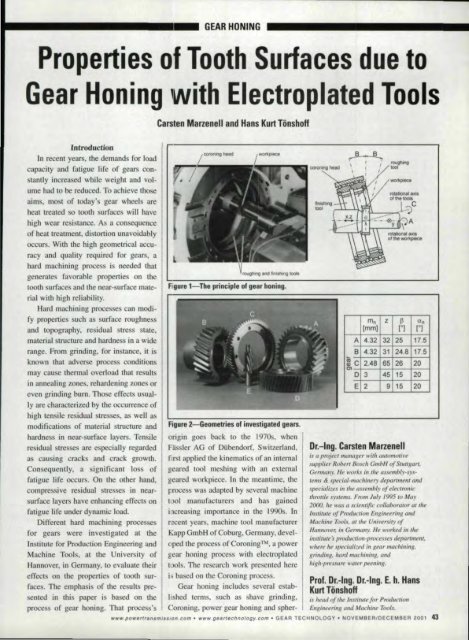Download the November/December 2001 Issue in PDF format
Download the November/December 2001 Issue in PDF format
Download the November/December 2001 Issue in PDF format
Create successful ePaper yourself
Turn your PDF publications into a flip-book with our unique Google optimized e-Paper software.
GEAR<br />
HONINGI<br />
Properties of Tooth Surfaces due to<br />
Gear Hon<strong>in</strong>q with Electroplated Tools<br />
ICarslen MalrzeneU and Hans Kurt TOnshofl<br />
Introduction<br />
In recent years, <strong>the</strong> demands for load<br />
capacity and fatigue life of gears constantly<br />
<strong>in</strong>creased while weight and volume<br />
had 10 be reduced. To achieve rho e<br />
aims. rno t of today's gear wheels are<br />
heal treated oiooth surfaces will have<br />
high wear resi lance. A a con equence<br />
or heal treatment, distortion unavoidably<br />
occurs. With <strong>the</strong> high geometrical accuracy<br />
and quality required for gears, a Il<br />
hard mach<strong>in</strong><strong>in</strong>g proce s is needed that<br />
generate, favorable properties on <strong>the</strong><br />
tooth surface and <strong>the</strong> near-surface mate- Figure I-<strong>the</strong> pT<strong>in</strong>cip'le ot gear hon<strong>in</strong>g l •<br />
.rial with high reliability.<br />
Hard mach<strong>in</strong><strong>in</strong>g proce se can modify<br />
properties such as surface roughness<br />
and topography. residual stress slate<br />
material structure and hardness <strong>in</strong> a wide<br />
range. From gr<strong>in</strong>d<strong>in</strong>g. for <strong>in</strong>stance. it is<br />
known that adverse process conditions<br />
may cause <strong>the</strong>rmal overload that re ults<br />
<strong>in</strong> anneal<strong>in</strong>g zones. reharden<strong>in</strong>g zones. or<br />
even gr<strong>in</strong>d<strong>in</strong>g bum. Tho e effects usually<br />
are characterized by <strong>the</strong> occurrence of<br />
hardness <strong>in</strong> near-surface layers. Tensile<br />
re idual stresses are especially<br />
regarded<br />
as caus<strong>in</strong>g crack and crack growth.<br />
Consequently, a significant loss of<br />
fatigue life occurs. On <strong>the</strong> o<strong>the</strong>r hand,<br />
compressive re idual stresses <strong>in</strong> nearsurface<br />
layer have enhanc<strong>in</strong>g effects on<br />
fatigue life under dynamic load.<br />
Different hard macil<strong>in</strong><strong>in</strong>g processes<br />
for gears were <strong>in</strong>vestigated at <strong>the</strong><br />
Institute for Production Eng<strong>in</strong>eer<strong>in</strong>g and<br />
Mach<strong>in</strong>e Tools, at <strong>the</strong> University of<br />
Hannover, <strong>in</strong> Germany, 10 evaluate <strong>the</strong>ir<br />
effects on <strong>the</strong> properties of tooth sur-<br />
r-:;;;;;;;;;;;;:;:::;:;::;::;::;:::;::;:::;;:;;::;;;-----------I<br />
hi~gh tensile residual stresses, as well as<br />
modifications of material structure and Figure,2"""""Geomehieso. <strong>in</strong>vestigated gars ..<br />
orig<strong>in</strong> goes back to jhe 1970s, when<br />
Fassler AG of Dabendorf, Switzerland,<br />
fJrst applied <strong>the</strong> k<strong>in</strong>ematics of an <strong>in</strong>ternal<br />
geared 1001 mesh<strong>in</strong>g with an external<br />
geared workpiece. In <strong>the</strong> meantime, <strong>the</strong><br />
process was adapted by several mach<strong>in</strong>e<br />
tool manufacturers and has ga<strong>in</strong>ed<br />
hcreas<strong>in</strong>g importance <strong>in</strong> tile 1990 .In<br />
recent years, mach<strong>in</strong>e tool manufacturer<br />
Kapp GmbH of Coburg. Germany. developed<br />
<strong>the</strong> process ofCoronillg, a power<br />
gear hon<strong>in</strong>g process with electroplated<br />
tools. The research work presented here<br />
i,based on <strong>the</strong> Coron<strong>in</strong>g process.<br />
...<br />
Or.-Ing'. Carsten<br />
mn z ~ an<br />
~mmI I"} (OJ<br />
A 4.32 32 25 17.5<br />
B 4.32 31 24.8 17.5<br />
I'll<br />
III C 2.48 65 26 20<br />
01<br />
10 3 45 15 20<br />
IE 2 9' 15 .20<br />
M,arzeneU<br />
is a projeet manager with automotive<br />
supplier Robrrt Bosch. GmbH of Stuttgart,<br />
Germany. He works <strong>in</strong> <strong>the</strong> assembly-systems<br />
& special-mach<strong>in</strong>ery department fIIUJ<br />
specializes <strong>in</strong> <strong>the</strong> assembly of electronic<br />
throttle systems. From July 1995 10 May<br />
2000. he II'(U (I scientific collaborator {It thl!<br />
Institute of Production Eng<strong>in</strong>eer<strong>in</strong>g and<br />
Mac/l<strong>in</strong>e Tool. at <strong>the</strong> University of<br />
Hannover; ill GemlllllY. He worked ill rile<br />
<strong>in</strong>stitute's production-processes department.<br />
where he sperializrd ill gear mach<strong>in</strong><strong>in</strong>g,<br />
gr<strong>in</strong>d<strong>in</strong>g. hard marh<strong>in</strong><strong>in</strong>g, and<br />
high-pressure water peen<strong>in</strong>g.<br />
Prof. O'rAng ..10r,~I:ng.E. h. Hans<br />
face. The emphasis of <strong>the</strong> result presented<br />
<strong>in</strong> tills paper L based 011 <strong>the</strong> lished terms, such as shave gr<strong>in</strong>d<strong>in</strong>g. is Ireatj of <strong>the</strong> Institute for Production<br />
Gear hon<strong>in</strong>g <strong>in</strong>cludes several estab-<br />
Kurt Ti<strong>in</strong>shofl<br />
proces of gear hon<strong>in</strong>g. That process's Coronmg, power gear hon<strong>in</strong>g and spher- Eng<strong>in</strong>eer<strong>in</strong>g Wid Mllclrille Tools .<br />
..... "'.powertrlltlsmfss'on.com •.. w ....g.eart·9chnology com' GEAR TECHNOLOGY' NOVEM'BERIDECEMBER <strong>2001</strong> 43,<br />
I<br />
I<br />
I

















